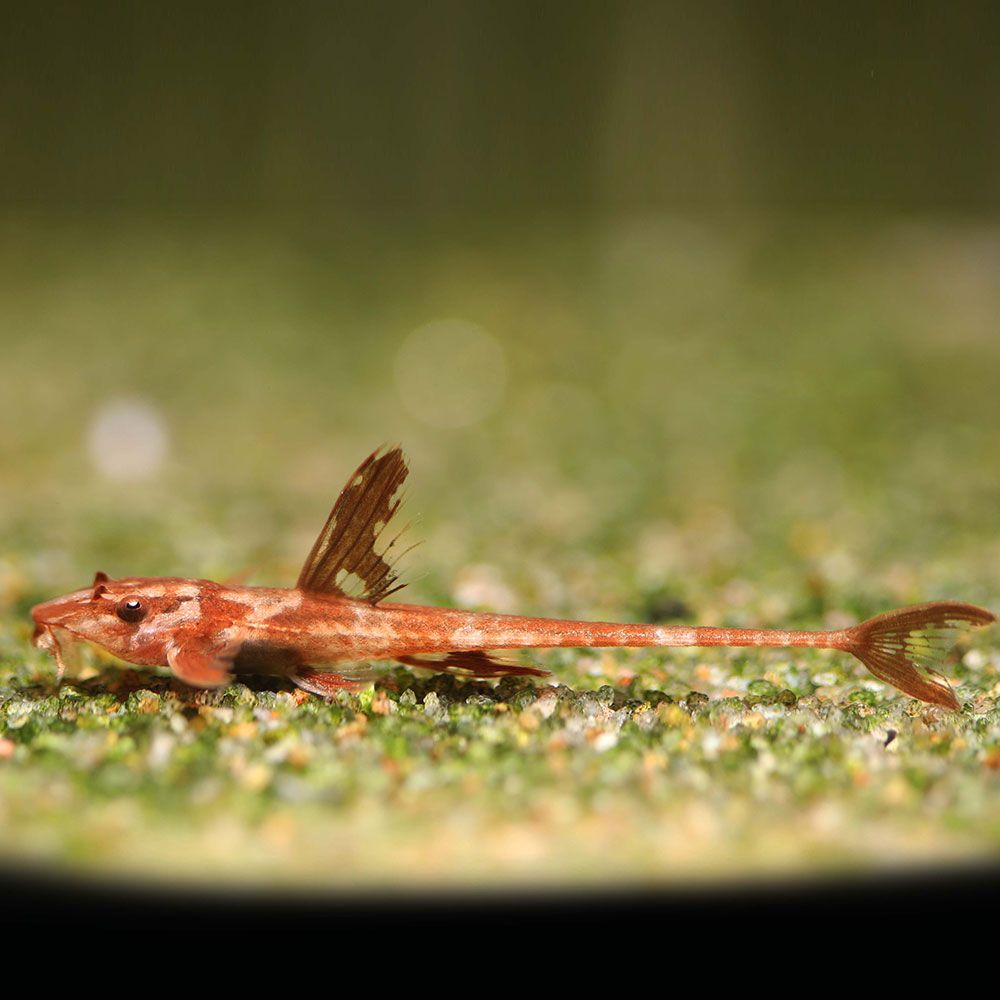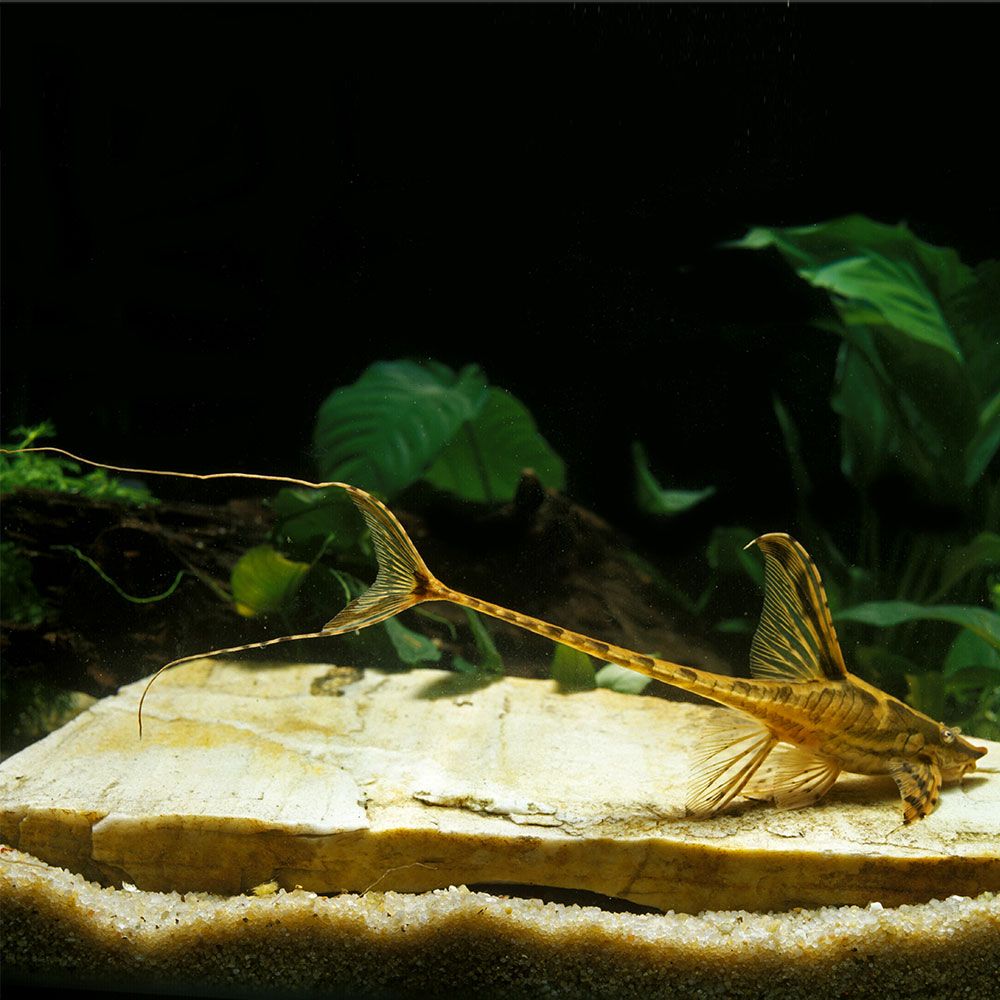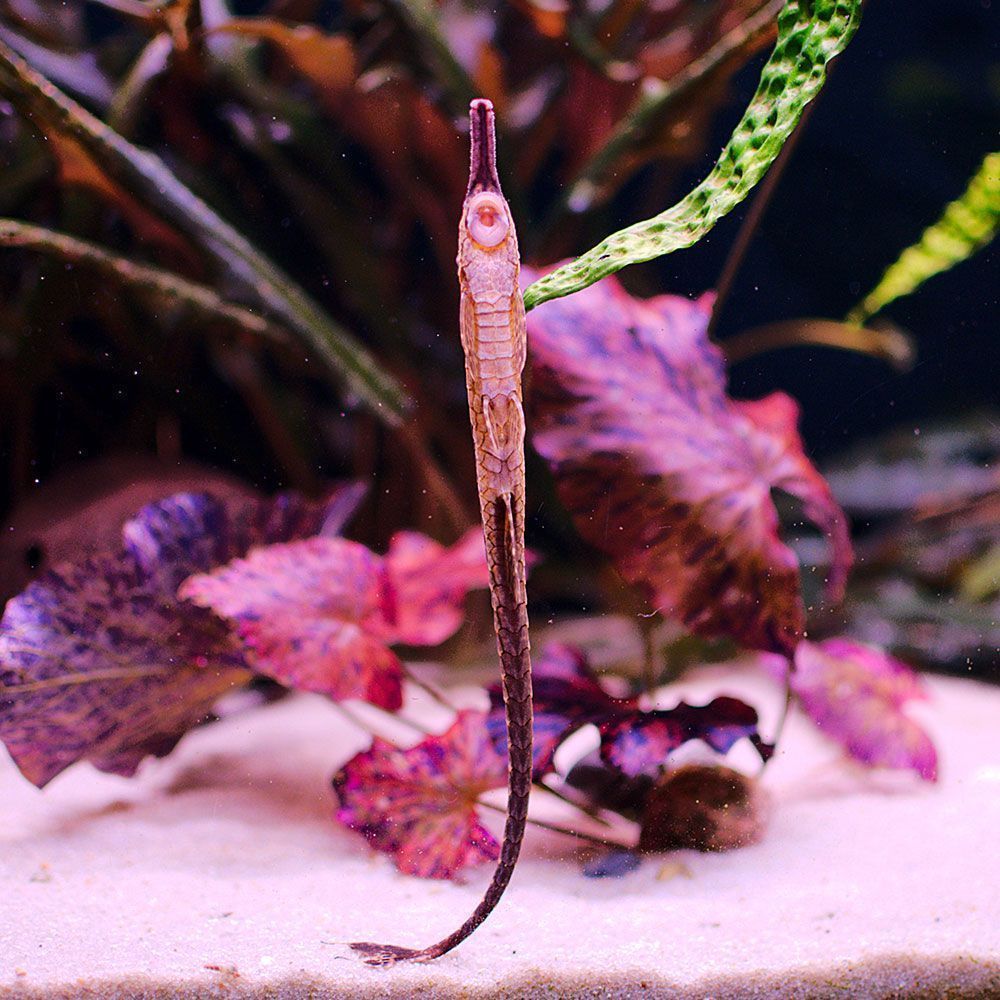The whiptail catfish is one of the most peaceful and loving species. It almost resembles a miniature dragon but means no harm to tank mates. The fish is so rare that owning and maintaining one will make all hobbyists respect your skills.
Specifically, it is great for intermediate aquarists’ species-specific or well-researched community tanks.
What is a Whiptail Catfish?
A Whiptail Catfish is a rare freshwater fish that looks like the end part of a whip and that is where it gets it’s name from.
| Origin | Lake Valencia, Torito River basins, South America |
| Order | Siluriformes |
| Family | Loricariidae |
| Scientific Name | Farlowella acus |
| Common Names | Whiptail catfish, Twig catfish |
| IUCN Red List Status | Vulnerable |
| Appearance | Elongated, slim yellowish brown to olive green body with blotches at some places. |
| Size | Up to 18 cm (7.01 in) |
| Lifespan | Usually around 5 years, but 10 or more years with the best care |
| Temperament | Peaceful, non-territorial, solitary |
| Tank Level | Bottom to middle dwellers |
| Water Temperature | 73.4-78.8 °F (23-26 °C) |
| pH Level | 6.0-7.0 |
| Water Hardness | 3-10 dGH |
| Care Level | Moderate |
| Minimum Tank Size | 40 gallons for one alone, more for conspecifics and other tank mates |
| Tank Environment | Sandy substrate, branches, planted, shaded, enough swimming space |
| Diet | Primarily herbivorous, likes wood |
| Tank Mates | Same species or genus, similar-sized or smaller, calm and non-aggressive species |
Which family of fish does Whiptail Catfish belong?
Currently, under the order Siluriformes, the Loricariidae family, and the Loricariinae subfamily, multiple species are called “whiptail catfish” because their top caudal fin ray extends to a filament that looks like a long whip. This makes their body seem similar to a crocodile.
There are about 30 different genera of whiptails, but some of them are yet to be introduced to the aquarium trade.
And each is unique based on its natural habitat, color, features, habits, fins, tail types, and so on.
While the entire article will revolve around the whiptail catfish – Farlowella acus – let’s quickly learn about the most popular whiptails!
What are the Types of Whiptail Catfish?
While multiple types of whiptail catfish exist, only a few are popular and well-researched in the trade.
So, while you try to buy one, the sellers most frequently also have these options available. C’mon, let’s get to know those better here!
1. Red Lizard Whiptail Catfish (Rineloricaria sp.)

- Natural Habitat: Paraguay River, Negro River and basins, Colombia, Bolivia, Brazil, and Paraguay of South America
- L Number: L010A
- Size: 11 cm (4.33 in) or more
- Lifespan: Up to 10 years or more
- Tank Level: Bottom dwellers
- Temperament: Peaceful
- Diet: Omnivorous
- Tank Mates: Other calm, friendly, and similar-sized species
The red lizard whiptail has an elongated and flattened orange or red body. It has multiple bony plates on its body with a sucker-like mouth on the ventral side of the head.
Unlike the female, the adult male fish has short spines on its head and pectoral fins.
2. Royal Whiptail Catfish (Sturisomatichthys panamense)

- Natural Habitat: Caribbean Rivers, Colombia; Pacific Rivers, Colombia, Panama, and Ecuador
- Other Common Names: Royal Twig Catfish
- Size: Up to 26 cm (10.23 in)
- Lifespan: Usually 5 years; Up to 10 years with proper care
- Tank Level: Bottom dwellers
- Temperament: Very Peaceful, Solitary
- Diet: Omnivorous but with a sparing (weekly once) carnivorous diet
- Tank Mates: Non-aggressive and small tank mates
It has an extremely elongated, thin, and yellowish brown body with extensions on its tail called “streamer.” There are black marks on its sides.
The adult male fish has teeth-like structures on its head and snout, but the females don’t. The male also has a long first dorsal fin.
What is the Habitat of Whiptail Catfish (Farlowella acus)?
The fish is naturally spotted in the mainland of Colombia and Venezuela in Lake Valencia drainage and River Torito (Orinoco drainage).
Moreover, it is also rarely noticed in tributaries of the upper regions of the Meta and Guaviare Rivers.
It usually swims in the demersal region of these freshwater bodies, i.e., 0-5m depth, and prefers to stay in highly vegetated areas. The Farlowella avoids open and clear water and frequents wherever it can camouflage.
According to the latest assessment of 2020, the fish’s IUCN Red List Status is Vulnerable. In simpler words, its population is decreasing consistently.
Whiptails under the Farlowella genus are also called twig catfish because they have a thin twig-like body that helps them camouflage in the wild.
The Farlowella acus is an armored catfish and type species of its genus.
It is also popular by other scientific names like Acestra acus, Loricaria scolopacina, and Farlowella scolopacina.
How does Whiptail Catfish look?

Whiptails have fascinating bodies and features. So, if you want to familiarize yourself with this fin buddy, get started!
What is the Size of Whiptail Catfish?
This fish can grow up to 18 cm (7.01 in).
What is the Color of Whiptail Catfish?
Its body color varies from yellow or yellowish brown to olive green.
There is a prominent irregular dark band and blotches from its head, through the eyes, to the tail root. It also has rays with dark blotches and transparent fins. All the caudal lobes have a dark band.
What are the Features of Whiptail Catfish?
Like all Farlowellas, this has a long and slim body with a prominent rostrum. The dorsal fin is near the middle region of the body, right in front of the anal fin, and its mouth is on the underside of its body.
Its body has many scutes, especially on its stomach; there are closely approximated rows of lateral scutes.
But compared to all other Farlowellas, this one has a much shorter and blunt rostrum. The head is the widest part of its body. Its posterior body looks like that of a crocodile.
How are male and female Whiptail Catfish different?
Along the side of the rostrum, the male fish has long teeth-like structures which help in breeding. This is absent in the female fish.
The female’s snout is much more smooth instead.
What is the behavior of Whiptail Catfish?
The species is extremely peaceful, non-territorial, diurnal, and bottom-dwellers. But if there’s vegetation or branches in the middle region of your tank, it may also hide there.
What is the Lifespan of Whiptail Catfish?
In captivity, the fish can live at least up to 5 years. With quality care, the longevity of twig catfish can be extended to about 8-10 years.
Author’s Note: Twig catfish hardly move around because it is always alert and wants to stay camouflaged from predators. Due to this habit, new pet owners often get worried about their health.
How to take care of Whiptail Catfish?
Now, you’re probably concerned about maintaining the best tank conditions for your fish. So, head right in here.
What is the Tank Size for Whiptail Catfish?
You need a 40-gallon tank, minimum, to house one of them. Many suggest that 30 gallons will suffice, but it’s not ideal.
Moreover, if you want to add more twig catfish of the same or different species or other tank mates, you must upgrade to a 70-gallon tank.
Make sure the tank lid is tightly closed as it is a jumper fish
What is the Water Chemistry for Whiptail Catfish?
Next, keep in mind that the fish is sensitive to water conditions and maintain these parameters at all costs.
- pH Levels: 6.0-7.0
- Water Temperature: 73.4-78.8 °F (23-26 °C)
- Water Hardness: 3-10 dGH
- Ammonia: 0 ppm
- Nitrite: 0 ppm
- Nitrate: Below 10 ppm
What is the Tank Environment for Whiptail Catfish?
But good water isn’t enough to keep your whiptails stress-free. So, go one step further with these…
Is Substrate required for Whiptail Catfish?
Use dark and soft sand substrate in the tank. This will help the fish camouflage better when it’s at the bottom and make it confident enough to explore everywhere.
Avoid gravel substrate as it can hurt the fish’s sensitive body.
Are Plants required for Whiptail Catfish?
Don’t be discouraged from adding some plants like hornwort and wisteria to your tank. This helps the twig catfish to hide and be mistaken as a twig among the plants.
However, it may uproot plants as it is a root eater. So, you can also add some floating plants.
Which Lighting suits Whiptail Catfish?
Use dim lighting to make your pet fish comfortable and at peace.
Which Décor is best for Whiptail Catfish?
Add bogwood, driftwood, and decaying leaf litter to mimic its native land. However, do it in moderation and keep plenty of open space for swimming.
Which Filtration system does Whiptail Catfish require?
Use a robust filtration system that can keep the water clean and oxygenate it considerably. You must only perform slight water changes slowly every week; otherwise, the fish may get stressed.
What is the Water Flow Rate for Whiptail Catfish?
Medium to slow water flow rate is the most suitable.
Fish Care Tip: The fish is susceptible to water parameters, so invest in a reliable and accurate testing kit. You can protect your fish and sustain it for longer this way.
Never let the tank temperature reach above 84 °F (29 °C).
What do Whiptail Catfish eat?
This catfish is a suckermouth and loves to munch on algae and biofilm and sometimes even wood, but that won’t fill it properly. It is most happy on a herbivorous meal, and you must feed it meaty things sparingly. So, always serve a healthy meal for this fish with the following:
- Plant-based sinking pellets
- Blanched vegetables (spinach, lettuce, cucumber, and zucchini)
- Algae wafers
- Fruits
Once or twice a week, it would be best if you fed it a small portion of protein-rich meaty foods like
- Shrimp pellets
- Chopped microworms
Make sure you feed them a consistent meal regularly to create a healthy dietary routine and also stabilize tank conditions. Give it two meals a day, and don’t overfeed it.
The fish is not picky, so it can adapt to frozen, freeze-dried, dry, and live-feed pretty fast.
What are the Tank Mates for Whiptail Catfish?
Since the twig catfish is shy and sensitive, many recommend keeping it in a species-only tank. This is where you keep it with the same or other Farlowella species. Remember, the wrong pairing can lead to health concerns.
However, if you still want to add it to your community tank, make sure you only keep it with other calm, laidback, and friendly species of similar or smaller sizes.
So, some possible tank mates are peaceful species like
- Otocinclus
- Parotocinclus
- Sturisoma genera
- Corydoras
- Small characins
- Rasboras
Which Tank Mates to Avoid for Whiptail Catfish?
A lively and expressive fish can stress this fin buddy and lead to serious problems. So, avoid the following aquatic animals in the same tank:
- Barbs
- Cichlids
- Large loricariidae
- Fin nippers
- Fast shoaling swimmers
- Any bigger fish – their bioload will increase toxins and nitrates in the tank too fast and make the twig sick
Most of these species will steal the twig catfish’s food, and since the twig is comparatively slow, it won’t be able to fight back. This may lead to malnutrition and poor health.
What are the Common Diseases for Whiptail Catfish?
Many believe that whiptail catfish are hardy and don’t contract diseases easily. But it’s always wise to be watchful of the following conditions:
| Disease Name | Causes | Symptoms | Treatment |
|---|---|---|---|
| Columnaris | Bacterial infection | White or gray patches, frayed fins, appetite loss, inactivity | Improve water quality, add antibiotics, manage the stress of the fish |
| Ich | Protozoan parasite | White spots, flashing, appetite loss, inactivity | Add ich medicines, elevate water temperature |
| Fin rot | Bacterial infection | Frayed or disintegrated fins, redness or discoloration on fins, appetite loss, inactivity | Improve water parameters, remove physically injurious objects from the tank, add antibiotics |
| Flukes | Parasitic infection | Red spots, more than normal mucus secretion, heavy breathing, appetite loss, inactivity | Improve water conditions, put it on a proper diet, medicated baths, oral medicines, or injections |
| Plecostomus disease | Fungal infection | White cotton-like growth on its body | Quarantine and add medicine |
The fish can contract other bacterial and fungal infections as well. In most cases, proper antibacterial and antifungal medicines (respectively) with regular water changes and a healthy diet can help.
Quick Tips
- Some say that the fish is resistant to Ich and fin rot, but don’t assume anything, as this is not scientifically proven yet.
- Never use potassium permanganate and copper medicines, as they are scale-less fish.
How to Breed Whiptail Catfish in a tank?
It is assumed that this whiptail catfish breeds similar to the remaining Farlowellas, but there’s minimal information on this fish successfully breeding in home aquariums.
However, commercial breeders say it’s not hard to induce spawning in pristine water conditions like follows:
- 79 °F temperature
- Steady water hardness
- Regular cleaning
But make sure to mimic the environment of the natural habitat during November-March.
Lastly, you must have an equal number of males and females to avoid aggression and competition.
You won’t see the mating process as the fish is too shy and proceeds only when there’s no external disturbance. But the remaining process goes as follows:
What is the Breeding Process of Whiptail Catfish?
The male fish cleans a suitable hard surface of the tank for spawning. The female fish lays up to 80 eggs on that surface at night or in the morning.
What is the Incubation Period of Whiptail Catfish eggs?
The male fish fertilizes the eggs and takes care of the batch during the incubation period. It mouths and fans the fertilized eggs using the pectoral fins throughout this time.
The incubation period lasts up to 10 days but often varies depending on the temperature.
What is the Fry Development Process of Whiptail Catfish?
However, once the eggs hatch, proper feeding can be tricky. It’s better to shift the fry to a separate mature tank so the young can live on the plant material and micro bacteria.
You can also feed them deskinned and smashed green peas. Make sure you sprinkle this in a visible area so you can notice the leftovers and clean it up easily.
Breeding Tip: Some feed the fry zucchini, cucumber, and lettuce. However, all fry may not accept it, which can lead to the loss of young ones.
How to Buy Whiptail Catfish?
You can get your hands on the Farlowella acus only if you live in its native countries. Since the fish is nearly extinct, it has hardly ever been exported outside.
Moreover, the species is mainly raised by reputed and knowledgeable aquarists. So, if you want to get the real deal, contact clubs specializing in this species.
In my experience, many unaware aquarists have experienced unexplained deaths of this species. I am sure you don’t want to be one of them.
A word from FishInAquarium
With that, you know everything that the whiptail catfish needs to live comfortably with you. And if you’re satisfied with all the unique things you learned with us, share it with other fish enthusiasts.
But if you have more questions before you house the fish, drop us a mail, and we’ll help you out!


